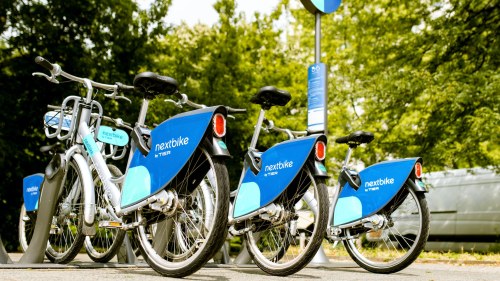Safety and Culture Key to Realizing Micromobility's Climate Benefits

A Council working paper shows the climate benefits of shared mobility, but urban leaders must implement policies that make it safer and more accessible.
Shared micromobility services, such as bicycles and e-scooters, have grown increasingly popular in cities across the world as residents seek new ways to get around. Aside from alleviating congestion, these new transportation modes offer a climate-friendly alternative to car travel—particularly in places that don’t have efficient, dense, and dependable public transit networks.
In a recent Council working paper published with the Shared Use Mobility Center, the authors find that micromobility’s potential to reduce emissions is greatest in medium-density areas with lower transit access—where it’s most likely to replace car trips. However, in the US, not all cities that fall into this category offer the ideal conditions for micromobility. Bike- and scooter-friendly cities like Portland, Oregon, offer excellent case studies for car-centric metros like Los Angeles looking to scale micromobility use.
A Tale of Two Cities
In the American context, medium-density cities with lower transit usage include Los Angeles, Minneapolis, Portland, San Jose, and Seattle, all of which have between 4,500 and 8,500 people per square mile and maintain public transit systems which less than 20 percent of the population uses regularly.
These cities can be broken further into two categories: bike havens and bike deserts. Research shows this disparity is likely due to several factors, including a city’s biking infrastructure, overall levels of road safety, and its history of bike culture—all of which impact the prevalence of cycling as a form of transportation.
Portland
Portland is consistently ranked among the top five major US cities for biking by industry experts and cycling enthusiasts. It’s no surprise, then, that the city also has the highest percentage of commuters who go by bike, at 6.3 percent.
What makes Portland such a biking mecca? Rankings of cities’ bike infrastructure can be methodologically precarious, but the League of American Bicyclists scorecard for Portland—the only “platinum” ranking in America—offers several insights. Portland scores highest on mainstreaming its biking culture and the planning of its bike infrastructure. That infrastructure is critical to making cyclists feel safe, with 90 percent of new cycling investments from 2016-2021 made on protected infrastructure such as off-street trails.
The comprehensive nature of Portland’s bike infrastructure gives commuters the ability to ditch their cars for many trips. A study by the Urban Institute found that 53 percent of Portland libraries are within one-quarter mile of secure cycling infrastructure, demonstrating that residents can access public institutions by bike.
Portland also has a deeply rooted biking culture that permeates its tourism efforts and public image. The city fosters this culture with an array of programs, including Portland Sunday Parkways, which periodically opens the city’s streets to pedestrians, bikes, and scooters. The results are impressive, with an average pf 24,000 people attending Sunday Parkways—90 percent of whom bike.
Los Angeles
On the other end of the spectrum is Los Angeles, a city with a reputation synonymous with car culture and traffic jams. From 2014-2016, more cyclists died in Los Angeles County than in every US state except Florida, New York, and California itself. Bicycling magazine labeled it the worst biking city in the US in 2018, calling its roads “a disaster” for riding bikes.
It’s no wonder, then, that only 1.2 percent of Angelenos commute by bike. The League of American Bicyclists, while noting the city’s progress on passing bike-friendly policies, gives LA a “bronze” rating—with its bicycle network and connectivity rated only four out of 10.
LA has many of the ingredients of a top tier cycling city—including warm, sunny weather and a straightforward street grid. But the poor quality and connectivity of its biking infrastructure currently limits the city’s ability to increase ridership and lessen its dependence on cars.
As The Guardian noted in 2021, many of LA’s bike lanes lead to nowhere. And an examination of Los Angeles County’s bikeways map shows that the network is far less dense and comprehensive than Portland’s, meaning it’s more difficult to replace typical car trips with bikes or scooters. In fact, the same Urban Institute study showed that only 19 percent of LA libraries are within a quarter mile of secure cycling infrastructure—a sign of how challenging getting from Point A to Point B can be.
And, given that “Los Angeles is a product of the automobile,” its local bicycle culture, although growing, remains niche and underdeveloped. Bike infrastructure funding has lagged even as LA has increased sales taxes to fund road and transit work.
The Path Forward
Reducing greenhouse gas (GHG) emissions to meet climate goals won’t happen without decarbonizing the transportation sector, which accounts for 27 percent of all emissions in the US. But alternative transportation methods won’t gain mass appeal if residents can’t get to and from their destinations in a safe, affordable, and efficient manner.
Building protected bike lanes and lowering speed limits are key to scaling micromobility, particularly because they increase rider safety and the perception of safety. The Council’s working paper offers a number of other solutions as well.
According to the report, city policymakers should work to ensure “that transit and micromobility are complementary rather than competitive.” This can be achieved, for example, by placing bike and scooter docks near transit to facilitate last-mile rides.
In terms of land use and zoning regulations, policymakers can eliminate parking—both on the street and in new developments—to reduce car dependence and make roads safer for smaller vehicles. And given that costs can make micromobility prohibitive for middle- and lower-income residents, cities like Denver have found e-bike rebates and subsidies to be extremely popular and effective.
But this is only part of the story. As the case of Portland demonstrates, cities can foster a positive micromobility culture through programming that brings these transport modes into the mainstream. Without a cultural sea-change in how we get around, micromobility will simply remain a hobby while cars continue to clog our roads and air.

